This was published 8 months ago
Pennsylvania is now the centre of the US political universe, and both candidates know it
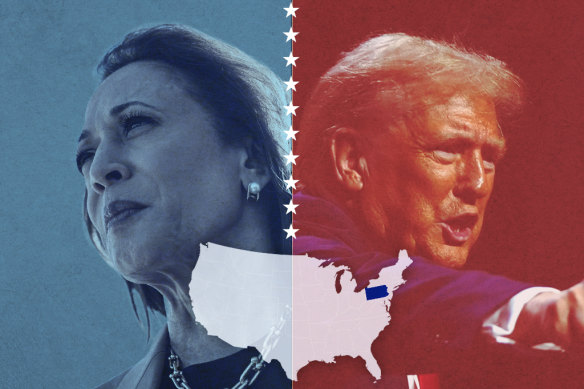
Kamala Harris and Donald Trump have very different economic plans.Credit: Matthew Absalom-Wong
Butler, Pennsylvania: It’s sunset in Pennsylvania and Elon Musk is bouncing jubilantly on a stage, his hands raised in the air as Donald Trump makes his defiant return to the showgrounds where he was almost killed by a would-be assassin.
“The true test of someone’s character is how they behave under fire,” Musk tells the crowd in Butler, 12 weeks after the attempted murder of the Republican presidential candidate stunned the world.

Elon Musk jumps on the stage as Republican presidential nominee Donald Trump speaks at a campaign rally in Butler, Pennsylvania, on October 5.Credit: AP
“We had one president who couldn’t climb a flight of stairs and another who was fist-pumping the air after getting shot. Fight! Fight! Fight!”
It was an unusual display of enthusiasm from the billionaire entrepreneur, who only two years ago posted on social media that Trump, now 78, should “hang up his hat and sail into the sunset”.
These days, however, the Tesla boss is a full MAGA convert. Not only did he endorse Trump seconds after the former president’s near-death experience in July, his political action committee – which was set up to back Trump’s candidacy – is now offering people money to identify potential Republican voters in the seven battleground states that will decide this year’s election.
And of all those battlegrounds, Pennsylvania stands apart as the one that both Trump and Democratic nominee Kamala Harris believe could tip the election.
“If we win Pennsylvania,” Trump told the rally last week from behind bulletproof glass, “we win the whole thing.”
Home to 13 million people in America’s so-called “rust belt”, Pennsylvania is known for many things: the battle of Gettysburg; the birthplace of US independence; the famed Philly cheesesteak.
Now, with less than a month until the presidential election on November 5, it’s also the centre of the political universe.
What makes this battleground so important is that it has 19 Electoral College votes up for grabs, which is the biggest haul of all the swing states in play this year. (Candidates have to receive 270 Electoral College votes to become president.)
In many ways, it’s also a microcosm of the political realignment of the two major parties. Democrats held Pennsylvania for 24 years until Trump narrowly beat Hillary Clinton in 2016 by securing the support of rural and working-class voters outside major cities such as Philadelphia and Pittsburgh, many of whom felt forgotten by the political class.
President Joe Biden managed to win back Pennsylvania four years later, but he had the advantage of being a home-town boy. He was born in the working-class city of Scranton, which was once home to generations of coal miners and rail workers, and is married to Jill Biden, who hails from the suburbs of Philadelphia.
“Pennsylvania is the kind of place that climbs into your heart and never leaves you,” the president told supporters this week at a fundraiser for Democrat Bob Casey, whose Senate battle could tip the balance of power in the US Congress.
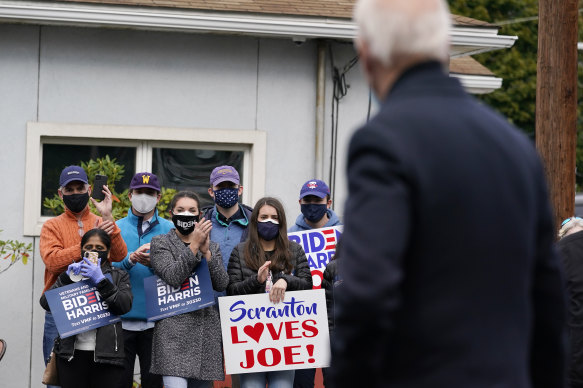
Joe Biden addresses a socially distanced crowd in his hometown of Scranton during the 2020 election campaign.Credit: AP
“Trust me, I know. I was born here, and I married a Philly girl.”
The big question now is whether Harris can follow suit and win the so-called Keystone State, which has selected the eventual president eight times in the past 10 elections.
While the vice president began her national campaign with extraordinary momentum, the latest FiveThirtyEight poll shows she remains virtually tied with Trump.
Democrats in Pennsylvania have also entered the final stretch with their weakest voter registration advantage in years compared with Republicans.
When Trump won Pennsylvania in 2016, there were about 916,000 more Democrats than Republicans in the state. As of this week, that figure had diminished to 325,485.
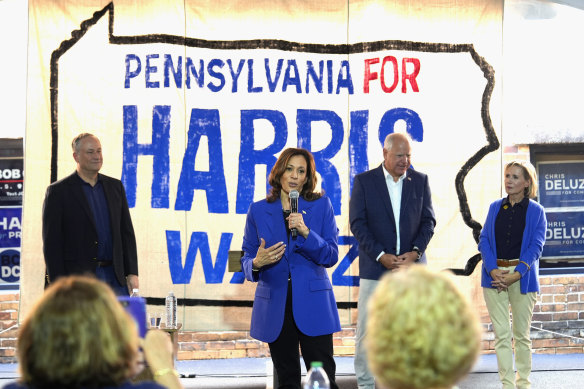
Vice President Kamala Harris speaks, watched by running mate Tim Walz (second from right) at a campaign event in Pennsylvania in August.Credit: AP
According to State Department figures, there are about 3.9 million registered Democrats in Pennsylvania; 3.6 million Republicans; and 1.1 million unaffiliated or independent voters.
“That tells me there are a lot of people who don’t feel a value proposition with either major party,” says Manufacturer and Business Association vice president Jezree Friend, a Republican from the bellwether city of Erie and adjunct professor at Gannon University, who has watched the demographics shift over the years.
“So the follow-up question then becomes: what happens with those independents?”
With so much at stake, it’s hardly surprising that both candidates are spending more time, money and energy in Pennsylvania than any other battleground – including the two other so-called blue wall states: Michigan and Wisconsin.
Trump, for example, kicked off the week with die-hard fans in Butler, followed by rallies in Scranton and Reading on Wednesday.
Musk also began garnering votes for the former president by offering $US47 – a nod to Trump potentially becoming America’s 47th president – to anyone who signs a petition supporting the First and Second Amendments and then refers someone else.
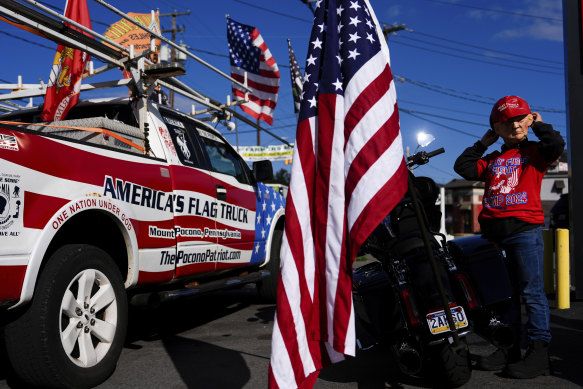
Trump supporters at a rally in Scranton on Wednesday.Credit: AP
“For every person you refer who is a swing state voter, you get $47!” he wrote on his social media platform X, as critics accused him of buying votes. “Easy money.”
Harris chose Philadelphia to announce her pick for running mate, Tim Walz, the Minnesota governor who Democrats hope will appeal to Midwest voters she might otherwise struggle to woo.
She also picked Pittsburgh as the backdrop to unveil her economic policy, which includes $US25,000 in down payment assistance for first-time home buyers; a $US6000 tax benefit for parents with newborns; and a $US50,000 tax deduction for start-up businesses.
On Thursday evening (Friday AEST), former president Barack Obama entered the fray with a rally there, too, aimed at motivating young people to support the Democratic nominee.
For resident Kit Ayars, it’s exactly the kind of mobilisation effort the Harris-Walz campaign needs.
“I understand that for some people, Trump’s personality and policies are resonating,” the Democrat said as she attended a get-out-the-vote concert headlined by former REM frontman Michael Stipe last week.
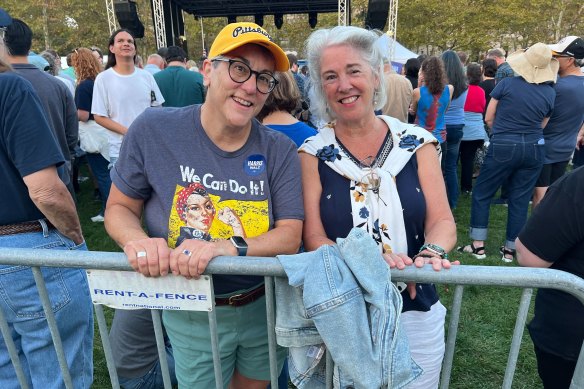
Cindy Abbott (left) and Kit Ayars at a Harris rally in Pittsburgh.Credit: Farrah Tomazin
“I don’t understand why, but I know it’s happening, so I do want to temper my optimism with that dose of reality,” Ayars said.
Butler resident Melissa Sehrecen is one of the voters Ayars is talking about. Asked why she supports the Republican candidate, she cites three things: the tax cuts Trump enacted as president; his hardline stance on illegal immigrants entering the country; and his strongman persona.
“I don’t think the United States is ready for a female president,” the social worker adds.
“I would rather have a man in charge – especially if we’re going into a bullfight with other countries.”
The Harris and Trump campaigns combined have also spent a whopping $US280 million on advertising in Pennsylvania between July 22 and October 8. According to tracking company AdImpact, this represents 21 per cent of all the battleground advertising expenditure over that period – more than any other state.
One of the ads that has resonated with voters targets Harris for being an original co-sponsor of the Green New Deal, a non-binding resolution pushed by progressives for the US to transition fully to clean energy within a decade.
It also attacks her for a pledge she made in 2019 to ban fracking, a process used to extract hard-to-access oil and natural gas. Harris has now reversed her position, knowing she needs to win over more working-class and union voters in Pennsylvania, which is the second-largest natural gas producer in the country after Texas.
“Energy is huge here – it directly employs about 300,000 people and then indirectly about three times that amount,” says Jezree Friend, from the Manufacturer and Business Association.
“So, was Kamala Harris being disingenuous in 2019 when she said she was 100 per cent against fracking and wanted to eliminate it? Or is she being disingenuous now when she says she’s a friend of the industry?”
Trump, however, also has some vulnerabilities.
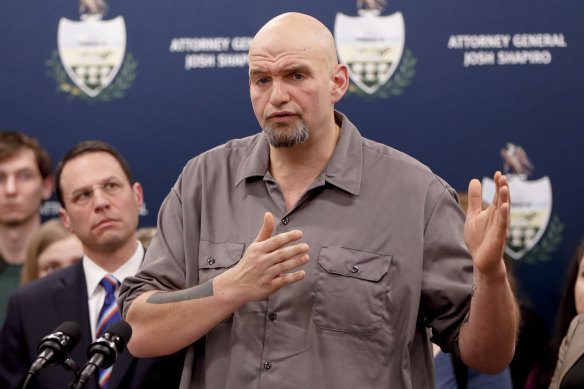
John Fetterman speaks as he stands beside Josh Shapiro during a news conference in 2020.Credit: AP
In terms of policy, abortion has been a galvanising force and helped Democrats to elect Josh Shapiro as Pennsylvania governor in 2022, flip a US Senate seat now held by John Fetterman and win control of the state House of Representatives.
In terms of demographics, the numbers of white voters without college degrees – who make up Trump’s base – are declining across the blue wall states, while independent and unaffiliated voter numbers are rising sharply.
And in terms of character, some voters haven’t forgotten that Trump has 88 criminal charges to his name, including 34 for which he will be sentenced next month after being found guilty of falsifying business records to cover up a sex scandal with porn star Stormy Daniels.
“Vote for the prosecutor, not the convicted felon,” declares one frontyard sign in the suburb of North Hills. “Sometimes ya gotta flush twice,” reads another in Cranberry Township, with an image of Trump and a white toilet.
“I’m cautiously optimistic,” Pittsburgh resident Cindy Abbott says.
“We’re not going to be an embarrassment to the rest of the planet any more, we’re not going to abandon our NATO allies, and we’re not going to let the government into our doctor’s office. We’re not going back.”
Sign up for our What in the world newsletter to get a special US election wrap-up every Tuesday plus a note from our foreign correspondents around the globe each Thursday.